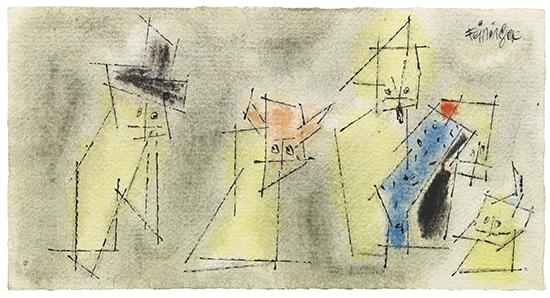1. THE COMPLETE FEININGER: – FOR THE FIRST TIME IN 25 YEARS
The German-American artist Lyonel Feininger (1871–1956) is a classic protagonist of modern art. The SCHIRN is dedicating an extensive retrospective to the important painter and graphic artist—the first in Germany in twenty-five years—thus providing an in-depth and surprising overall picture of his work. Feininger is known for his paintings of buildings, which are crystalline architectures with an unmistakable monumentality and harmony of color. The reception of his work today, however, often overlooks the originality and abundance of artistic facets in his oeuvre, which reflects numerous tendencies of modernity.
Lyonel Feininger is among the best-known representatives of classical modernism in Germany, but the many-sidedness of his art is nevertheless surprisingly unfamiliar to a broader audience.



2. SELF-PORTRAITS THAT REFLECT THE CHARACTER
At the start of the large retrospective, the Schirn presents drawn and painted self-portraits by Lyonel Feininger, including the expressive "Self-Portrait" (1915), which was shown in 1917 at his first solo exhibition at the Galerie Der Sturm in Berlin. In this gesture of self-reflection, Feininger portrays himself both skeptically and contemplatively. After coming to Germany from New York in 1887 to study in Leipzig, Feininger ultimately decided to pursue the visual arts at the academy in Berlin. He had his first success here as a leading caricaturist and illustrator, with drawings that make it possible to recognize his special sense of humor.

3. WORKS FROM THE MOST IMPORTANT COLLECTIONS IN THE WORLD
With roughly 160 paintings, caricatures, watercolors, woodcuts, photographs, and objects, the exhibition highlights important topics and lines of development that shaped Feininger’s work and make it unique. For the presentation, the Schirn was able to obtain important loans from numerous German and international museums, as well as public and private collections, and bring them together in Frankfurt. The lenders include, among others, the Bauhaus-Archiv Berlin; Harvard Art Museums/Busch-Reisinger Museum, Kunstmuseum Basel; The Metropolitan Museum of Art, New York; Museum Folkwang, Essen; The Museum of Modern Art, New York and Whitney Museum of American Art, New York.
4. EXPERIMENTAL WORK THAT IS USUALLY ONLY KNOWN TO EXPERTS
In addition to Feininger's world-famous paintings of crystalline architecture and woodcuts, the retrospective also brings together a large number of his lesser-known works. These include Feininger's photographs, which became increasingly abstract during his time in exile in the USA. Moreover Feininger occupied himself to a greater extent with color slides and once again took up familiar motifs and compositions from his work. By reexploring his painting "Broken Glass" (1927), he experimented with overlapping pieces of glass and light phenomena, which were continued on another visual level when the slides were projected.
The rarely shown series of watercolor and ink drawings, the “Ghosties”, was created a few years prior to his death in New York. They fathom the liberated lines of his late oeuvre and, similar to his caricatures and wooden toy figures, form a fascinating contrast to his monumental architecture paintings with their playful lightness.


Lyonel Feininger, Five Ghosties, circa 1953, Image via mutualart.com
5. FEININGER'S TOYS AT THE END OF THE WORLD
Feininger’s wooden toys, as already his caricatures and comics, are also an inseparable part of his total body of work. Starting in 1913, he worked on locomotives of colored hardwood, which were to be made in series, a plan that could not take effect due to the First World War. With “City at the End of the World” (1925–55), he created a toy city of wood that reflects his interest in historical buildings and churches and makes reference to the novel “Die andere Seite” (The Other Side, 1908) by his friend Alfred Kubin.

